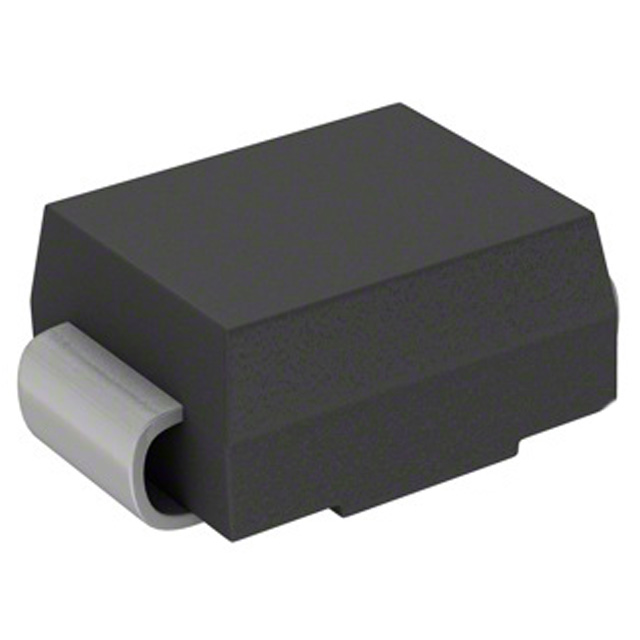Xem thông số kỹ thuật để biết chi tiết sản phẩm.

P6SMB56A
Product Overview
Category
The P6SMB56A belongs to the category of transient voltage suppressor (TVS) diodes.
Use
It is used to protect sensitive electronic components from voltage transients induced by lightning, inductive load switching, and electrostatic discharge.
Characteristics
- Fast response time
- Low clamping voltage
- High surge current capability
Package
The P6SMB56A is typically available in a DO-214AA (SMB) package.
Essence
The essence of the P6SMB56A is to provide robust protection against voltage surges to ensure the reliability of electronic circuits.
Packaging/Quantity
It is commonly packaged in reels or trays, with quantities varying based on manufacturer specifications.
Specifications
- Standoff Voltage: 47.8V
- Breakdown Voltage: 53V
- Maximum Clamping Voltage: 85V
- Peak Pulse Current: 67.9A
- Operating Temperature Range: -55°C to 150°C
Detailed Pin Configuration
The P6SMB56A TVS diode typically has two pins, with the anode and cathode connections clearly marked on the device.
Functional Features
- Bi-directional clamping capability
- Low incremental surge resistance
- High reliability
Advantages
- Provides effective protection against voltage transients
- Fast response time helps in minimizing damage to sensitive components
- Wide operating temperature range enhances versatility
Disadvantages
- May exhibit some leakage current in normal operation
- Clamping voltage may vary slightly based on operating conditions
Working Principles
When a voltage transient occurs, the P6SMB56A TVS diode conducts and clamps the transient voltage to a safe level, diverting the excess energy away from the protected circuit.
Detailed Application Field Plans
The P6SMB56A is widely used in various applications including: - Telecommunication equipment - Automotive electronics - Industrial control systems - Power supplies - Consumer electronics
Detailed and Complete Alternative Models
Some alternative models to the P6SMB56A include: - P6SMB10A - P6SMB18A - P6SMB30A - P6SMB36A
In conclusion, the P6SMB56A transient voltage suppressor diode offers reliable protection against voltage transients and finds extensive use across diverse electronic applications.
Word Count: 305
Liệt kê 10 câu hỏi và câu trả lời thường gặp liên quan đến ứng dụng P6SMB56A trong giải pháp kỹ thuật
Sure, here are 10 common questions and answers related to the application of P6SMB56A in technical solutions:
What is P6SMB56A?
- P6SMB56A is a type of transient voltage suppressor diode designed to protect sensitive electronic components from voltage spikes and transients.
What is the maximum working voltage of P6SMB56A?
- The maximum working voltage of P6SMB56A is 56V.
What is the peak pulse power handling capability of P6SMB56A?
- P6SMB56A can handle peak pulse power up to 600W under 10/1000μs waveform.
What are the typical applications of P6SMB56A?
- P6SMB56A is commonly used in applications such as telecommunications equipment, industrial control systems, automotive electronics, and consumer electronics to protect against voltage surges and ESD events.
What is the operating temperature range of P6SMB56A?
- The operating temperature range of P6SMB56A is typically -55°C to +150°C.
How does P6SMB56A provide protection against voltage transients?
- P6SMB56A clamps the voltage during transient events, diverting excess current away from sensitive components and limiting the voltage across the protected circuit.
Can P6SMB56A be used for overvoltage protection in power supply circuits?
- Yes, P6SMB56A is suitable for overvoltage protection in power supply circuits, providing a fast response to transient events.
What is the packaging type of P6SMB56A?
- P6SMB56A is available in a variety of package types, including DO-214AA (SMB) and DO-15 (DO-204AC).
Is P6SMB56A RoHS compliant?
- Yes, P6SMB56A is RoHS compliant, making it suitable for use in environmentally conscious designs.
Are there any recommended layout considerations when using P6SMB56A in a circuit?
- It is recommended to minimize the length of the traces between P6SMB56A and the protected components, and to ensure a low impedance path to ground for effective transient suppression.
I hope this information is helpful! Let me know if you need further assistance.

